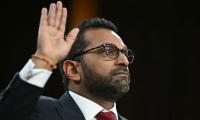As expected, Donald Trump’s return to the US presidency has injected a fresh wave of economic anxiety worldwide, reviving debates over trade, tariffs, and America’s role in the global order.
The arrival of Trump 2.0 marks a seismic moment, potentially unravelling the post-cold war era’s open-market model as Trump is expected to implement a fiercely protectionist agenda – a sure recipe of global uncertainty and a heightened Sino-US trade war. Trump’s economic strategy leans heavily on tariffs, proposing duties of up to 60 per cent on Chinese imports and 10–20 per cent on other foreign goods – levels reminiscent of the Great Depression.
In his previous term, tariffs affected $380 billion in US imports from China. This time, his proposals could impact tenfold that amount. Trump seriously believes that such an approach is essential to revitalise American manufacturing and curb inflation, particularly as household costs continue to strain many Americans.
Trump’s sweeping protectionist trade agenda signals a radical departure from decades of American economic policy, reflecting his commitment to reshaping US global economic relations. Trump claims that these tariffs will safeguard American jobs, spur domestic manufacturing, and reduce the nation’s reliance on foreign imports. But his agenda may have unintended consequences. The steep tariffs could exacerbate inflationary pressures, pushing up costs for consumers and sparking retaliatory trade measures. Similarly, he is a big proponent of eliminating levies on tips and social security benefits, along with cutting corporate taxes substantially – an attempt, he insists, to stimulate domestic growth and alleviate inflation. Trump’s first term saw similar measures, with 25 per cent tariffs on steel and 10 per cent on aluminium, framed as national security necessities. However, these moves triggered an immediate backlash.
Key allies, including Canada and the European Union, responded with retaliatory tariffs targeting American agricultural products – a counterpunch that dealt a sharp blow to American farmers. Should Trump proceed with a universal tariff, economists warn it would almost certainly invite a new wave of retaliation, potentially leading to an intense trade standoff with longstanding allies and partners.
Trump’s proposal also raises questions about US commitments to the World Trade Organization, where members committed to abide by tariff limits. By exceeding these, the US risks violating international rules, a move certain to heighten global tensions. History suggests that countries respond aggressively when they feel Washington bypasses established protocols, setting the stage for what could be a punishing trade conflict with consequences that resonate across both American and global economies.
Donald Trump insists that his tariff-heavy trade agenda and emphasis on revitalising US manufacturing will be a cure-all for inflation, ultimately easing the cost of living for American families. Trump argues that foreign producers would absorb the tariffs, shielding American consumers from higher prices. But economists and trade experts see a different picture: Tariffs, though intended to protect American industries, often end up costing consumers as importers pass along the added expenses.
The pattern is clear and straightforward: prices on imported goods would climb, with domestic products – frequently substitutes for imports – likely following. Trump’s stance on tariffs may also reverberate far beyond US borders, bringing unintended consequences to global markets. His proposed policies risk sparking a chain reaction of economic responses from trading partners, potentially escalating into a broader trade conflict.
In an interconnected world, such moves are rarely contained; a protectionist wave in Washington could disrupt supply chains, heighten tensions with allies, and impact economies that rely on stable trade with the US, leaving a lasting mark on global economic stability.
A study from the London School of Economics and Political Science projects that his policies could shrink China’s GDP by 0.68 per cent, with smaller yet notable contractions for the European Union (0.11 per cent) and economies like India, Indonesia, and Brazil. These anticipated shifts reflect broader anxieties about the global ramifications of such a US-centric trade policy. Another troubling point is Trump’s chronic intent to control the US Fed.
The Federal Reserve, with its mandate to control inflation and maintain stable labour markets, has long operated as an independent steward of American monetary policy. Although presidents indirectly influence the Fed mainly through appointments to its board, Trump has repeatedly expressed a desire for deeper control over its decisions. Throughout his previous tenure, he criticised the Fed’s interest rate hikes, arguing that a more accommodating policy would have supported his economic agenda and helped curb inflation. Trump’s push to influence the Fed’s direction raises fundamental concerns about central bank independence.
The Fed’s decisions directly impact the global economy, affecting everything from bond yields to currency values. If financial markets sense that the Fed's autonomy is at risk, the consequences could be dire. A politicised Federal Reserve would likely undermine investor confidence in US bonds and the dollar – assets traditionally seen as bedrocks of global stability. Economists warn that even the perception of weakened Fed independence could have far-reaching implications. The credibility of US monetary policy hinges on the Fed’s ability to act without political interference. Should Trump’s approach lead to greater political influence over monetary decisions, the ripple effects would extend far beyond America’s borders, potentially shaking global markets and diminishing trust in the dollar as the world’s reserve currency.
As Trump seeks to reclaim the White House, the world watches with apprehension, pondering the impact of his vision for the Fed. But with Trump’s well-known penchant for unpredictability, the real impact of his trade strategies is difficult to forecast. Many wonder whether he will stick to his proposed tariffs once in office, or if his impulses might steer the policy in unexpected directions. For now, the world is watching closely, weighing both the promises and potential pitfalls of Trump’s uncompromising trade agenda.
The writer is a freelance contributor.
We also have cases where people wait for years just to become actual citizens
Trump announces $500bn investment to build AI infrastructure and secure edge over international competitors
These figures reflect consistent investment patterns spanning at least decade
President Trump hints at possibility of imposing tariffs on EU and reciprocal tariffs on many countries
This change eliminated outdated civil service structure, replacing it with results-based governance model
Pakistan’s learning poverty rate stands at 77%, positioning it among the most challenged educational systems worldwide







